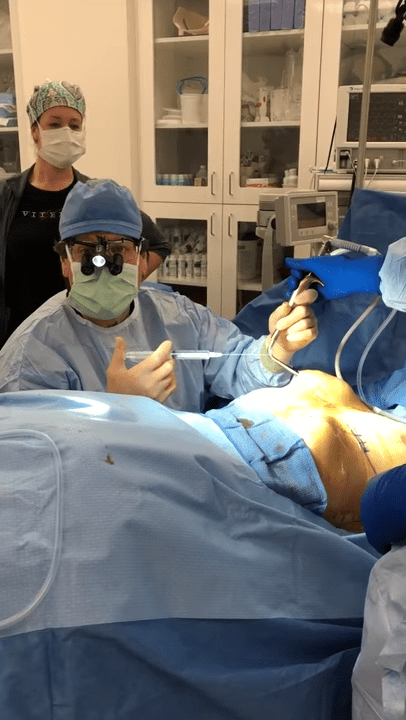30+ Years of Experience
3k+ Real Patient Reviews
10,000+ Breast Surgeries Performed
Texas Super Doctor
Breast Augmentation
Post-Surgery
Post surgery after breast augmentation, you’ll definitely need some time to heal. It’ll take a while before your final results are visible, which occurs after post-surgical swelling has gone down and your implants have had time to settle into place.
Reserve a Free VIP Consultation
Discover why patients from across the U.S. and around the world choose Dr. Vitenas as the premier surgeon for naturally-appearing breasts.

How Painful Is Breast Augmentation Recovery?
Pain is relative and what is very painful for one person might seem like only mild discomfort to another. For that reason, it’s difficult to say exactly how much pain or discomfort you’re likely to experience after breast augmentation.
Usually, though “soreness” persists for a few weeks after surgery, according to the Mayo Clinic. Many patients can manage the soreness or other types of discomfort with over-the-counter pain relievers.
If you do have more severe pain after surgery, your surgeon can prescribe medication to help. The American Society of Plastic Surgeons recommends only using prescription-strength pain medications for up to seven days after breast augmentation, however.
- Gentle Icing: Apply ice packs to the affected area to reduce swelling and alleviate pain. Wrap the ice packs in a cloth to avoid direct contact with the skin.
- Rest and Mobility: While rest is crucial, gentle movements are equally important. Light activities, such as walking around your home, can help reduce stiffness and aid in a smoother recovery process.
- The most intense discomfort typically occurs within the first few days following the surgery. However, most patients find that they can gradually return to their normal activities within 3-5 days as the pain subsides.
- You may feel particularly sore on the first morning after surgery. This is when your body is most actively engaged in the initial healing phase.
- We advise against certain pain medications, such as aspirin, as they can increase the risk of bleeding. For pain relief, you can consider over-the-counter options like acetaminophen. However, always consult with us for a personalized pain management plan.
- If prescribed pain medication, remember not to take it on an empty stomach and avoid driving or operating machinery due to potential drowsiness.
- If you experience any unusual changes in pain intensity or character, please contact our office immediately. Monitoring your pain is essential, as it can be an indicator of your recovery progress.
How to Manage Swelling After Surgery

Swelling after surgery is expected, due to inflammation and the body’s natural healing response. Although it usually is most noticeable several days after surgery, most of the swelling usually goes away on its own within a week or two.
Even though swelling is a normal part of the healing process, you can try to reduce it if you find it bothersome after surgery. Applying a cold compress or ice pack to the area will help reduce swelling.
You might also try eating pineapple, which contains an enzyme called bromelain, known to help minimize swelling, according to Mount Sinai.
How to Manage Post-Surgery Hematomas
A hematoma forms when blood collects outside of a blood vessel, as MedicineNet notes. Hematomas are somewhat different from bruises, which form when blood vessels break under the surface of the skin.
Both hematomas and bruises can develop after breast augmentation. Bruises will usually fade on their own but a hematoma might require attention from your plastic surgeon.
Signs of a post-surgery hematoma after breast augmentation include marked swelling on one side that is completely different than the opposite side. There is usually pain associated with the swelling
If a hematoma does develop, your surgeon will most likely return you to surgery to remove the hematoma and place a drain to treat it.

What to Wear After Breast Augmentation
Comfort is the name of the game after breast augmentation. You’ll want to wear clothing that is easy to put on and take off and that is comfortable enough to rest and relax in.
WHAT TYPE OF TOP TO WEAR POST-SURGERY
Loose-fitting tops that open in front are ideal after breast augmentation. You want your shirts to float away from the body so that the fabric doesn’t irritate the incisions or rub against your sore breasts. Since it might be uncomfortable to raise your arms over your head for several days after surgery, choosing shirts that open in the front and either zip or button up will make for the easiest dressing. A loose-fitting cotton button-up shirt or a zip-up hoodie might be a good choice. If you choose a shirt with a zipper, make sure the inside of the zipper won’t rub or irritate your skin or the area around the breasts.
WHAT TYPE OF BRA TO WEAR AFTER BREAST AUGMENTATION
The best bra after breast augmentation is no bra! Your breasts will need time to settle into place and heal and a bra can interfere with the process.
WHAT TYPE OF BOTTOMS TO WEAR POST-SURGERY
Comfy bottoms are the way to go post-breast augmentation surgery. You don’t have to reach for the sweatpants, but if you do, no one will judge you. Track pants or leggings are good picks, as are loose-fitting shorts or even a loose, flowing skirt.
Save the jeans for after you’re fully recovered. You don’t want to have to lounge around in anything too constricting.
Scarring After Breast Augmentation
Scars are part of the process with any surgery. As the skin heals, it produces collagen fibers, which are different in texture from the rest of the skin, according to WebMD.
How much scarring a person will have after surgery and how visible the scars will be depends on several factors, not all of which are under the surgeon’s control. Plastic surgeons do their very best to minimize scarring and to place incisions in hidden locations, such as around the nipples or in the breast crease.

What Affects Scarring?
Some people develop more visible scarring than others, for a range of reasons. Your age, your genetics, and your skin type can all influence the way the scars look in the long run.
For example, people with darker complexions are more prone to keloid scars, which are scars that grow beyond the border of the original incision. People with lighter complexions might have more of a contrast between the color of the scar and their skin color, making them more visible.
If you’ve spent years sunning yourself, you might be more likely to develop highly visible scars after surgery compared to someone with limited sun damage. How elastic the skin is will also affect the appearance and visibility of breast surgery scars.

How to Minimize Breast Surgery Scars
BEFORE SURGERY
While you might not be able to fully prevent the formation of scars after surgery, you can attempt to minimize their appearance. What you should do to minimize your scars depends on how far along you are in the healing process and how visible the scars have become.
Early on, some women find that taking preventative steps, such as eating a healthy diet and drinking plenty of water, helps the body heal after surgery and reduces scarring. On the other side of the coin, some habits can interfere with your skin’s ability to heal, making scarring worse.
For example, it’s important to quit smoking or using other types of tobacco products a few weeks before and after breast surgery. Nicotine limits blood flow and blood flow is crucial for proper healing.
You might also need to avoid certain types of medications and supplements before breast surgery. For example, some types of pain relievers, such as aspirin and ibuprofen, can increase bleeding, which can, in turn, affect scarring. Your surgeon will let you know what medicines and supplements should be avoided.
AFTER SURGERY
After you’ve had surgery, there are a few things you can do to treat your scars and minimize their appearance. Following any post-surgery instructions from your plastic surgeon will also help keep scars to a minimum. Your plastic surgeon will provide you with directions on how to clean and care for the incision sites.
You might be able to apply topical creams or ointments to the scars after your incisions have fully healed. Silicone products or vitamin E creams might help to reduce the visibility of scarring. It’s worth noting that you should wait a few weeks after surgery and after the incision has healed before you try massaging the scar or applying vitamin E. Ask your surgeon for advice. Also, remember that the scars will likely fade significantly over time.
If you do end up with raised scars or with keloid scars after your surgery, there are in-office treatments that might help. Laser treatments can help to reduce the size of a raised scar, for instance. Some patients also have success with steroid injections for prominent scars. Your plastic surgeon can recommend options to you and help you choose the one that will be the most likely to make your scars less noticeable.
Breast Surgery Scars Do Fade
How to Maintain Your Breast Implants
There is nothing positive about the term “high maintenance.” However, while it is easy to assume that once you have breast augmentation, you’re set for life, breast implants do need a bit of tending to from time to time.
Your implants will not become high maintenance if you take good care of them. Every so often, check on them to make sure things are going well. Following the advice of your surgeon will help you enjoy your implants for years to come.
Massage After Breast Augmentation Is a Must
Breast augmentation involves the creation of a pocket for the implant to rest in. Your body will heal after the surgery, which sometimes causes the pocket to become smaller and the scar tissue to get tougher. Massaging the breast area regularly, and performing exercises that should be demonstrated to you after the surgery will help ensure the pockets stay open and keep the scar tissue soft. Implant massage reduces the risk for capsular contracture, a complication that can occur when the scar tissue clamps around the implant and squeezes it. Routine massage also helps to create a natural-feeling breast. Your surgeon will most likely tell you to massage the area frequently, about every 30 minutes, for the first six weeks after the surgery (during waking hours). After the first six weeks, you’ll be advised to keep massaging at least twice a day to keep the pocket wide and the scar tissue soft. It is also a good idea to continue to massage your breasts long-term, especially after you get up and right before bed. If you have any questions about how to massage your breasts after implants, reach out to your surgeon’s office. They will be happy to help!
Know When to Wear a Post-Surgery Bra After Breast Augmentation
Go for Check-Ups, No Matter What
Be Cautious About Other Treatments When You Have Implants
If you are seeing a different doctor for another treatment or standard procedure, it is important to mention your implants. There is a small risk of infection when you have implants, and your doctor might want to prescribe antibiotics to considerably lower that risk. For example, if you are about to get your teeth cleaned by a dentist, there is a rare, yet potential chance that the bacteria found in your mouth during the cleaning can get into your bloodstream. This could travel to the area of the implant and cause problems. Since it’s a foreign object, your implant might be a more likely target for infection than other areas of the body. Although women with implants often see their dentists for years with few problems, it is always better to be safe and disclose your implants to all the medical professionals you work with.
Schedule A Consultation
What Not to Do After Breast Augmentation
What you do and what you don’t do during the breast augmentation post-op period will have a big impact on the overall results of your surgery and can play a role in whether or not your implants will develop any complications down the road. Even if the instructions your surgeon gives you seem a little out there, it’s important to follow them to a T to increase your chances of having a great result.
Your surgeon will give you specific advice, but here are a few basic things to avoid after your surgery.

1. Wearing a Bra
2. Drink Alcohol While Taking Medication
3. Skip Your Exercises
4. Go to the Gym
5. Smoke or Use Tobacco Products
6. Sleep on Your Side or Stomach
7. Have Sex
8. Take a Shower
9. Take Aspirin
10. Be Sedentary
11. Sun Yourself

How to Stay Positive After Breast Augmentation
You might expect to be absolutely thrilled or even over-the-moon after breast augmentation. You’ve done your research and have taken the time to invest in yourself and in a surgery that will help you feel more confident. Although plenty of women are extremely happy after their breast surgeries, it’s also not uncommon for some women to feel a bit sad or to develop post-surgical blues, known as postoperative depression.
Postoperative depression has some things in common with postpartum depression. Both occur after what are usually positive life events. Both can also severely interfere with your quality of life. There are ways to help prevent or minimize the feelings of sadness that can occur after surgery. Here’s what you can do to keep a positive outlook after your breast augmentation.
LEAN ON YOUR SUPPORT NETWORK
The more people you have to lift you up and support you during your recovery after breast augmentation, the better. It’s not only important for your emotional and mental health to have a group of people to support you, it’s also important because you might need some physical assistance after your surgery. This is particularly true on the first night after the procedure. You’ll want to have at least one friend or relative around to help you get home and to stay with you in case you need any help.
FIND WAYS TO FILL YOUR TIME
You’re going to need to take some time off from work or other activities as you recover from breast surgery. Getting off of your usual schedule can really throw you for a loop, so it’s a good idea to find meaningful ways to fill your time. That initial recovery period after breast augmentation might be an ideal time to pursue a new, quiet hobby. You could learn a new skill, such as painting or knitting. You can also use your recovery time to catch up on books or movies you haven’t gotten a chance to read or see yet.
EAT A HEALTHY DIET
It’s a good idea to stock your kitchen the right way before you have surgery. Prep quick and easy meals and snacks so that you don’t end up eating pizza or other types of unhealthy takeout while you recuperate. Getting plenty of fiber and other nutrients will help you feel more comfortable as you heal. A healthy diet will also help your body heal more quickly after surgery. It’s also important that you drink plenty of water and stay hydrated following your procedure.
LET YOURSELF REST
You need to give yourself permission to rest after your surgery, as getting plenty of sleep will help your body heal. In some cases, women struggle to rest after breast augmentation because they find it difficult to find a comfortable position for sleeping. It’s a good idea to make your bed extra comfortable, by adding pillows and blankets if needed during your recovery period. You will want to sleep on your back, so be sure to have pillows on either side of you to keep you from rolling over in your sleep.
KEEP A JOURNAL
Journaling can help you gather your thoughts and process your emotions. If you’re feeling down after surgery, write down how you feel. You might also consider keeping a journal that focuses on the positive things in your life. Every day, make a list of a couple of things you are grateful for or things that brought you happiness.
GET HELP IF YOU FEEL DOWN
Most importantly, if you do feel sad or depressed after your breast augmentation, seek help. Your surgeon can reassure you that what you’re feeling and the swelling and bruising you might be experiencing are normal and will subside. It can also be helpful to speak with other women who have had breast augmentation to learn more about how they coped with recovery. You might even consider speaking with a therapist who can help you sort through your feelings.


Why choose Dr. Vitenas
for Your Post-Operative Care After Houston Breast Augmentation?
Dr. Paul Vitenas, a board-certified plastic surgeon, is renowned for his expertise in breast augmentation, having achieved exceptional outcomes for thousands of patients. His extensive experience makes him a trusted expert in not only performing breast augmentations but also in providing comprehensive post-operative care.
Known for his caring and compassionate approach, Dr. Vitenas takes the time to listen and understand each patient’s unique needs and concerns during their recovery period. At Vitenas Cosmetic Surgery, we boast a state-of-the-art accredited surgical center equipped with the latest technology and advanced techniques. This ensures that every aspect of your breast augmentation journey, especially the crucial post-operative phase, is handled with the utmost precision and care.
Dr. Vitenas is dedicated to helping every patient feel more feminine, self-confident, and satisfied with her appearance, not just after the surgery but throughout the recovery process. He provides an exceptional experience from the initial consultation through to the final results, ensuring that your post-operative care is tailored to your specific needs for a smooth and comfortable recovery.
Breast Augmentation CareFAQ
Many people describe the recovery period after breast augmentation as somewhat uncomfortable. How much pain or discomfort you experience will depend on your body’s response, your pain tolerance, and what you do to prepare. There are ways to manage pain and make recovery more comfortable.
Usually, you’ll want to wait at least two or three weeks before sleeping on your side again after breast augmentation. Sleeping on your back minimizes pressure on the breasts and helps aid the healing process.
Your plastic surgeon will let you know when it’s safe to go swimming again after surgery. Usually, you can expect to start swimming around the time you can start up vigorous exercise again, around four to six weeks after breast augmentation.
Wait at least two or three weeks before having sex again after breast surgery. You might find it too uncomfortable to have sex before then.
Massaging the breasts is important for reducing the risk of capsular contracture and for helping the implants settle into position. If you find massage after breast augmentation painful, talk to your surgeon. They might recommend taking medication or using a gentler touch.
If you’re looking at breast augmentation stretch marks (post-surgery images) and are concerned you’ll get stretch marks after your own surgery, keep in mind that the healing process is highly individual. Some people get stretch marks, while others don’t. If you’ve gotten them in the past, such as during pregnancy, there is a chance that you will get them after breast augmentation.
Stretch marks do typically fade after surgery, although how long it takes for the marks to fade can vary from patient to patient.
Give your breasts time to heal and your implants time to settle before buying new bras. You might want to schedule a bra fitting at a lingerie or department store to be sure you’re buying the correct size for your new breasts.
If you have more questions about what to expect after breast augmentation, Dr. Paul Vitenas, a board-certified plastic surgeon in Houston, Texas, can answer them. Dr. Vitenas specializes in breast procedures and has more than 30 years of experience helping women get natural-looking results. To schedule a consultation, call 281-226-9920 today.

